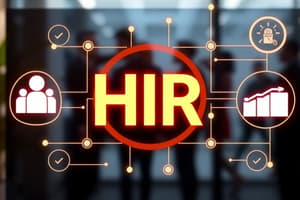Podcast
Questions and Answers
What was a key reason for the automation of data collection in the Social Issues Period (1963-1980)?
What was a key reason for the automation of data collection in the Social Issues Period (1963-1980)?
- To reduce the number of employees in HR departments
- To justify cost increases against productivity improvements (correct)
- To enhance traditional HR functions
- To improve employee satisfaction ratings
Which technological introduction is associated with the Social Issues Period (1963-1980)?
Which technological introduction is associated with the Social Issues Period (1963-1980)?
- The Internet
- Cloud Computing
- Personal Computers
- IBM 360 (correct)
How did the approach to HR activities shift during the Cost-Effectiveness period (1980-1990s)?
How did the approach to HR activities shift during the Cost-Effectiveness period (1980-1990s)?
- From administrative to developmental HR activities
- From transformational to transactional HR activities
- From transactional to strategic HR activities (correct)
- From operational to consultative HR activities
What is the primary focus of the Balanced Scorecard (BSC)?
What is the primary focus of the Balanced Scorecard (BSC)?
Which category of resources is considered the most critical for competitive advantage?
Which category of resources is considered the most critical for competitive advantage?
Which metric is commonly used in strategic HRM as mentioned for the Technology Advancement Era (1990s-today)?
Which metric is commonly used in strategic HRM as mentioned for the Technology Advancement Era (1990s-today)?
What were companies pressured to justify during the Cost-Effectiveness phase?
What were companies pressured to justify during the Cost-Effectiveness phase?
Which of the following perspectives is NOT part of the Balanced Scorecard (BSC)?
Which of the following perspectives is NOT part of the Balanced Scorecard (BSC)?
What is the primary focus of a Transaction Processing System at the operational level?
What is the primary focus of a Transaction Processing System at the operational level?
Which system provides key data to managers for ongoing decisions?
Which system provides key data to managers for ongoing decisions?
What is a major goal of an Executive Information System?
What is a major goal of an Executive Information System?
Which example is associated with a Management Information System?
Which example is associated with a Management Information System?
What is a common characteristic of Transaction Processing Systems?
What is a common characteristic of Transaction Processing Systems?
Executive Information Systems are primarily used for which purpose?
Executive Information Systems are primarily used for which purpose?
Which of the following is NOT a focus area of Management Information Systems?
Which of the following is NOT a focus area of Management Information Systems?
Which aspect of Executive Information Systems assists managers with strategic direction?
Which aspect of Executive Information Systems assists managers with strategic direction?
What was a significant characteristic of HRM during the period from 1945 to 1960?
What was a significant characteristic of HRM during the period from 1945 to 1960?
Which of the following describes the primary focus shift in the cost effectiveness era from 1980-1990?
Which of the following describes the primary focus shift in the cost effectiveness era from 1980-1990?
What technological advancement characterized the social era of HRM from 1963 to 1980?
What technological advancement characterized the social era of HRM from 1963 to 1980?
During which period did HR departments begin to face pressure to harness computer technology effectively?
During which period did HR departments begin to face pressure to harness computer technology effectively?
What was a notable feature of HR departments during the transition to strategic traditional HR activities from 1963 to 1980?
What was a notable feature of HR departments during the transition to strategic traditional HR activities from 1963 to 1980?
How did the emergence of computer technology impact HRM functions in the period of 1945 to 1960?
How did the emergence of computer technology impact HRM functions in the period of 1945 to 1960?
What did the protector function of HRM primarily focus on during the social era?
What did the protector function of HRM primarily focus on during the social era?
Which was a key factor that slowed the adoption of computer technology in HR departments during the 1963-1980 period?
Which was a key factor that slowed the adoption of computer technology in HR departments during the 1963-1980 period?
What is the first phase of the System Development Life Cycle (SDLC)?
What is the first phase of the System Development Life Cycle (SDLC)?
Which phase of the SDLC involves executing the designed system?
Which phase of the SDLC involves executing the designed system?
What drives the HR programs according to the model of organizational functioning?
What drives the HR programs according to the model of organizational functioning?
How does national culture affect organizational functioning?
How does national culture affect organizational functioning?
Which of the following is NOT one of the five phases of the SDLC?
Which of the following is NOT one of the five phases of the SDLC?
What is the role of HRIS in HR management systems?
What is the role of HRIS in HR management systems?
What types of metrics are involved in the interaction of HR processes?
What types of metrics are involved in the interaction of HR processes?
Which aspect is NOT mentioned as influencing organizational functioning?
Which aspect is NOT mentioned as influencing organizational functioning?
What was the primary focus of the HR department before World War II?
What was the primary focus of the HR department before World War II?
Which of the following factors contributed to the evolution of HRM postwar between 1945-1960?
Which of the following factors contributed to the evolution of HRM postwar between 1945-1960?
Which HR activities are part of the three types of HR functions mentioned?
Which HR activities are part of the three types of HR functions mentioned?
What essential function of HRIS was established before World War II?
What essential function of HRIS was established before World War II?
What was the prevailing management philosophy prior to World War II?
What was the prevailing management philosophy prior to World War II?
Which external factor has increased the need for HRIS in the modern context?
Which external factor has increased the need for HRIS in the modern context?
What significant change occurred in the HR profession during the postwar period?
What significant change occurred in the HR profession during the postwar period?
What is one major purpose of an HRIS?
What is one major purpose of an HRIS?
What is the primary purpose of a Human Resources Information System (HRIS)?
What is the primary purpose of a Human Resources Information System (HRIS)?
Which of the following components are NOT included in HRIS?
Which of the following components are NOT included in HRIS?
In which type of decision-making does HRIS primarily assist with monitoring work time and attendance?
In which type of decision-making does HRIS primarily assist with monitoring work time and attendance?
What distinguishes Electronic Human Resource Management (E-HRM) from HRIS?
What distinguishes Electronic Human Resource Management (E-HRM) from HRIS?
Why is it important to have a single, integrated database in HRIS?
Why is it important to have a single, integrated database in HRIS?
Which process is improved by the use of HRIS in organizations?
Which process is improved by the use of HRIS in organizations?
Which of the following best describes the role of technology in HRIS?
Which of the following best describes the role of technology in HRIS?
What is a key benefit of converting data into information in HRIS?
What is a key benefit of converting data into information in HRIS?
Flashcards
Pre-World War II HR
Pre-World War II HR
HR departments were known as personnel functions, focused on record-keeping using manual methods. Management philosophy was scientific management. Minimal government influence.
Post-War HR (1945-1960)
Post-War HR (1945-1960)
HR focus shifted to employee morale and systematic worker classification. Labor unions emerged, impacting HR's role and recordkeeping. Specialist HR divisions evolved, including recruitment, training.
HR Information System (HRIS)
HR Information System (HRIS)
A system for managing HR data and processes. Can include recruitment, training, pay, and benefits.
Early HR Role
Early HR Role
Signup and view all the flashcards
Impact of Technology on HRM
Impact of Technology on HRM
Signup and view all the flashcards
Importance of Employee Morale
Importance of Employee Morale
Signup and view all the flashcards
Government Regulations and HRIS
Government Regulations and HRIS
Signup and view all the flashcards
Post-World War 2 HR
Post-World War 2 HR
Signup and view all the flashcards
Social Issues Period (1963-1980)
Social Issues Period (1963-1980)
Signup and view all the flashcards
Cost-Effectiveness (1980-1990s)
Cost-Effectiveness (1980-1990s)
Signup and view all the flashcards
1945-1960 HR
1945-1960 HR
Signup and view all the flashcards
Technology Advancement Era (90s-Today)
Technology Advancement Era (90s-Today)
Signup and view all the flashcards
Social Era HR (1963-1980)
Social Era HR (1963-1980)
Signup and view all the flashcards
Balanced Scorecard (BSC)
Balanced Scorecard (BSC)
Signup and view all the flashcards
Cost Effectiveness Era (1980-1990)
Cost Effectiveness Era (1980-1990)
Signup and view all the flashcards
HRIS Emergence
HRIS Emergence
Signup and view all the flashcards
Competitive Advantage & Resources
Competitive Advantage & Resources
Signup and view all the flashcards
HRIS definition
HRIS definition
Signup and view all the flashcards
HRIS components
HRIS components
Signup and view all the flashcards
HRIS Purpose
HRIS Purpose
Signup and view all the flashcards
HRIS user types
HRIS user types
Signup and view all the flashcards
E-HRM relation to HRIS
E-HRM relation to HRIS
Signup and view all the flashcards
HRIS benefits
HRIS benefits
Signup and view all the flashcards
Operational Systems
Operational Systems
Signup and view all the flashcards
Managerial Systems
Managerial Systems
Signup and view all the flashcards
Executive Systems
Executive Systems
Signup and view all the flashcards
Transaction Processing Systems
Transaction Processing Systems
Signup and view all the flashcards
Management Information Systems
Management Information Systems
Signup and view all the flashcards
Executive Information Systems
Executive Information Systems
Signup and view all the flashcards
Payroll Processing
Payroll Processing
Signup and view all the flashcards
SDLC Phases
SDLC Phases
Signup and view all the flashcards
SDLC End
SDLC End
Signup and view all the flashcards
Organizational Functioning Model
Organizational Functioning Model
Signup and view all the flashcards
HR Goals & Programs
HR Goals & Programs
Signup and view all the flashcards
HRIS Importance
HRIS Importance
Signup and view all the flashcards
HR Metrics & ROI
HR Metrics & ROI
Signup and view all the flashcards
National Culture Impact
National Culture Impact
Signup and view all the flashcards
Strategic Management & HRM
Strategic Management & HRM
Signup and view all the flashcards
Study Notes
Chapter 1: Evolution of Human Resource Management and Human Resource Information Systems
- The changing role of human resources (HR) professionals is discussed.
- The impact of computer technology on the evolution of HRM and HRIS is covered.
- Three types of HR activities are described.
- The purpose and nature of an HRIS, and the differences in information systems functionality within an HRIS, are explained.
- The role of information from an HRIS in organizational decision-making is examined.
Need for HRIS: External Environment
- Government regulations are a driving force for HRIS implementation.
- The EEO-1 Report plays a critical role.
- Employee composition significantly impacts HRIS needs.
- Increased records and reports contribute to the need for HRIS.
- Court decisions influence HR policies and practices, necessitating an HRIS.
- New laws also influence the adoption and use of HRIS.
Pre-World War II HR
- HR departments were previously known as "Personnel function."
- HR activities were primarily focused on caretaker tasks, like maintaining records (Record Keeping Manual).
- Scientific management was the prevailing management philosophy.
- Government influences on HR were minimal at the time.
- Record-keeping is a fundamental function integrated into modern HRIS designs.
Post-War (1945-1960)
- Employee morale became critical during this period.
- Efforts to categorize workers based on occupational categories and job descriptions increased.
- Labor unions emerged and influenced HR practices, demanding systematic record-keeping and reporting to governmental agencies.
- Specialized divisions like recruitment, training, and government relations were established.
Social Issues Period (1963-1980)
- Social issues legislation significantly influenced HR.
- Legislation focused on protecting employees' rights and well-being.
- There was a strong need automate data collection, analysis, and report generation.
- Decreasing computer technology costs and increasing costs of employees played a key role in automating HR functions.
- Introduction of IBM 360 and the advent of Management Information Systems (MIS) played an imperative role in reducing operating costs.
- Personnel (HR) managers were pressured to justify the cost increases in staffing against productivity improvements.
Cost-Effectiveness (1980-1990s)
- Cost reduction through automation of processes remained a key driver.
- Increased use of HR Information Systems (HRIS) continued.
- HR activity cost justification became important.
- HR shifted from primarily transactional activities to traditional and transformational HR activities.
Technology Advancement Era (1990s-Present)
- Globalization, technological breakthroughs, and hyper-competition significantly impacted this era.
- Strategic HRM (RBV) emerged as a crucial concept.
- Use of metrics such as HR Balanced Scorecard (BSC), Return on Investment (ROI), and Human Resource Planning (HRP) became widespread.
Balanced Scorecard (BSC)
- The Balanced Scorecard (BSC) is a performance management and measurement tool.
- It was developed in the 1990s.
- The aim is to help managers achieve strategic goals.
- BSC measures performance in four perspectives: Learning and growth, Internal processes, Customers, and Financial.
Cost-Effectiveness Era (1980-1990s) and Technological Advancement Era (1990s-Present)
- Overall focus shifted from employee administration to employee development, and employee involvement became crucial.
- Transformational activities were emphasized.
- HRM focused on strategic HR activities.
- Strategic HRM utilized HR Balance Scorecards.
HRIS Definition and Purpose
- Computerized systems that acquire, store, manipulate, analyze, retrieve, and distribute HR information are the core of an HRIS.
- HRM and managerial decisions are facilitated through an HRIS.
- HRIS comprises people, policies, procedures, and data, transcending the software and hardware.
- Increased storage and retrieval of data and new information generation are vital benefits.
- HRIS leads to reduced administrative costs, improved productivity, and faster response times.
Examples of HR Data
- Examples of HR data include recruitment, training, payroll, benefit administration data.
- Other relevant data might include source-to-hire, time-to-fill statistics, cost per hire, conversion rates, candidate experience, and candidate retention data.
Questions (Review of Important Topics)
- HRIS is defined as a computerized system used to acquire, store, manipulate, analyze, retrieve, and distribute information about an organization's human resources to support HRM and managerial decisions.
- HRIS encompasses more than just computer hardware and software; It includes people, policies, procedures, and data.
HRIS Definition & Variety of Users
- HRIS is designed to provide accurate and timely information for decision-making.
- HRIS caters to different user groups, including strategic users focusing on long-term decisions (e.g., facility expansion) and operational users focused on day-to-day activities (e.g., timekeeping and attendance).
- Tactical users are also involved in evaluating and improving processes (e.g., training programs).
E-HRM and HRIS
- Electronic Human Resource Management (E-HRM) leverages technology to improve HR operations.
- HRIS improves and supports HR processes and improves delivery and effectiveness to both HR staff and employees.
Why Do We Need HRIS?
- HRIS offers a comprehensive, unified view of employee data.
- It enhances HR operations and management processes, leading to improved competitiveness.
- Converting data into actionable information empowers improved and timelier decision-making.
- HR-related reports are produced more accurately and frequently.
- Streamlined and enhanced efficiency and effectiveness in HR administrative functions.
- A shift in focus from transaction processing to strategic HRM.
- Reengineering HR processes and functions.
- Improved employee satisfaction through more timely and accurate HR services.
Factors Affecting HRIS Implementation
- Organization size. Larger organizations often benefit more from HRIS.
- Top management support and commitment.
- Availability of resources (time, money, personnel).
- Employee ability and motivation to adapt to changes and increased automation.
Information Systems Supporting HRM
- Operational: Transaction processing systems (payroll, time and attendance).
- Managerial: Management information systems (producing reports, supporting ongoing decisions).
- Executive: Executive information systems (supports long-range planning and strategic decisions).
- Boundary Spanning: Decision support systems (supports interactive decision-making). Expert systems (integrating human knowledge). Office automation systems (document design, scheduling). Collaboration technologies (communication and collaboration support). Enterprise resource planning (ERPs) integrate data across functions.
System Development Life Cycle (SDLC)
- The SDLC consists of planning, analysis, design, implementation, and maintenance phases.
- Continuous evaluation is an ongoing process.
Organizational Functioning Model
- The organic model highlights the critical role of HRIS in organizational operation.
- HRIS is strongly linked to the strategic management system and goals.
HR Goals, Programs, and Metrics
- HR goals drive HR programs for effective employee use.
- HRIS becomes increasingly important in supporting HR management and strategic planning.
- HR metrics, cost-benefit results, value-added, and return on investment (ROI) contribute to continuous interaction.
National Culture and Organizational Impacts
- National culture significantly impacts the entire organizational model through its influence on the external environment.
- The external environment influences internal organizational functioning.
- Strategic management and HRM interaction improves organizational functioning.
Studying That Suits You
Use AI to generate personalized quizzes and flashcards to suit your learning preferences.
Related Documents
Description
This quiz covers the transformation of Human Resource Management and Human Resource Information Systems. It explores the changing role of HR professionals, the influence of technology on HRM, and the importance of HRIS in organizational decisions. Additionally, it highlights external factors driving the need for HRIS.




